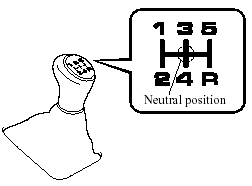Manual Transaxle Operation
Manual Transaxle Shift Pattern

The shift pattern of the transaxle is conventional, as shown.
Depress the clutch pedal all the way down while shifting; then release it slowly.
A safety feature prevents accidental shifting from 5 to R (reverse). The shift lever must be put in neutral before being shifted to R.
WARNING.
Do not use sudden engine braking on
slippery road surfaces or at high
speeds:
Shifting down while driving on wet,
snowy, or frozen roads, or while
driving at high speeds causes sudden
engine braking, which is dangerous.
The sudden change in tire speed could cause the tires to skid. This could lead to loss of vehicle control and an accident.
Be sure to leave the shift lever in 1 or R position and set the parking brake when leaving the vehicle unattended: Otherwise the vehicle could move and cause an accident.
CAUTION.
 Keep your foot off the clutch pedal
Keep your foot off the clutch pedal
except when shifting gears. Also,
do not use the clutch to hold the
vehicle on an upgrade. Riding the
clutch will cause needless clutch
wear and damage.
 Make sure the vehicle comes to a
Make sure the vehicle comes to a
complete stop before shifting to R.
Shifting to R while the vehicle is still moving may damage the transaxle.
NOTE.
If shifting to R is difficult, shift back into neutral, release the clutch pedal, and try again.
Recommendations for Shifting
Upshifting
For normal acceleration, we recommend these shift points.
| Gear | Vehicle speed |
| 1 to 2 | 21 km/h (13 mph) |
| 2 to 3 | 39 km/h (24 mph) |
| 3 to 4 | 55 km/h (34 mph) |
| 4 to 5 | 78 km/h (49 mph) |
For cruising
| Gear | Vehicle speed |
| 1 to 2 | 18 km/h (11 mph) |
| 2 to 3 | 29 km/h (18 mph) |
| 3 to 4 | 47 km/h (29 mph) |
| 4 to 5 | 68 km/h (42 mph) |
Downshifting
When you must slow down in heavy traffic or on a steep upgrade, downshift before the engine starts to overwork. This reduces the chance of stalling and gives better acceleration when you need more speed.
On a steep downgrade, downshifting helps maintain safe speed and prolongs brake life.
See also:
Sunvisors
When you need a sunvisor, lower it for
use in front or swing it to the side.
Vanity Mirrors
To use the vanity mirror, lower the
sunvisor. ...
Seat Belt Extender
If your seat belt is not long enough, even
when fully extended, a seat belt extender
may be available to you at no charge from
your Authorized Mazda Dealer.
This extender will be only for you and ...
Instant Mobility System (IMS) Emergency Flat Tire Repair Kit
The IMS emergency flat tire repair kit
included with your Mazda is for a
temporary repair of a slightly damaged
flat tire resulting from running over nails
or similar sharp objects on the road
su ...


